2014 SUBARU TRIBECA warning
[x] Cancel search: warningPage 358 of 426
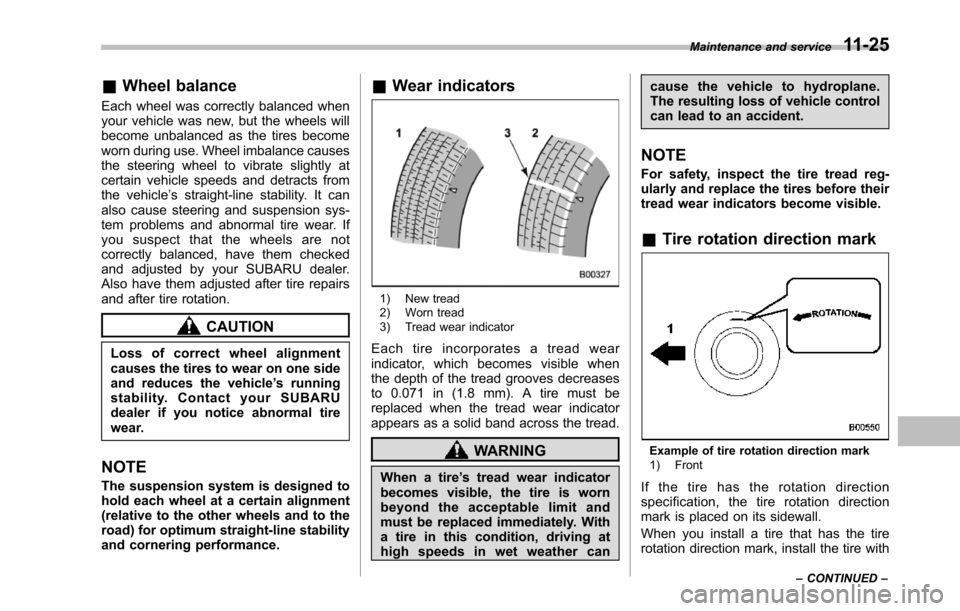
&Wheel balance
Each wheel was correctly balanced whenyour vehicle was new, but the wheels willbecome unbalanced as the tires becomeworn during use. Wheel imbalance causesthe steering wheel to vibrate slightly atcertain vehicle speeds and detracts fromthe vehicle’s straight-line stability. It canalso cause steering and suspension sys-tem problems and abnormal tire wear. Ifyou suspect that the wheels are notcorrectly balanced, have them checkedand adjusted by your SUBARU dealer.Also have themadjusted after tire repairsand after tire rotation.
CAUTION
Loss of correct wheel alignmentcauses the tires to wear on one sideand reduces the vehicle’s runningstability. Contact your SUBARUdealer if you notice abnormal tirewear.
NOTE
The suspension system is designed toholdeach wheel at a certain alignment(relative to the other wheels and to theroad) for optimum straight-line stabilityand cornering performance.
&Wear indicators
1) New tread2) Worn tread3) Tread wear indicator
Each tire incorporates a tread wearindicator, which becomes visible whenthe depth of the tread grooves decreasesto 0.071 in (1.8 mm). A tire must bereplaced when the tread wear indicatorappears as a solid band across the tread.
WARNING
When a tire’s tread wear indicatorbecomes visible, the tire is wornbeyond the acceptable limit andmust be replaced immediately. Witha tire in this condition, driving athigh speeds in wet weather can
cause the vehicle to hydroplane.The resulting loss of vehicle controlcan lead to an accident.
NOTE
For safety, inspect the tire tread reg-ularly and replace the tires before theirtread wear indicators become visible.
&Tire rotation direction mark
Example of tire rotation direction mark1) Front
If the tire has the rotation directionspecification, the tire rotation directionmark is placed on its sidewall.
When you install a tire that has the tirerotationdirection mark, install the tire with
Maintenance and service11-25
–CONTINUED–
Page 360 of 426
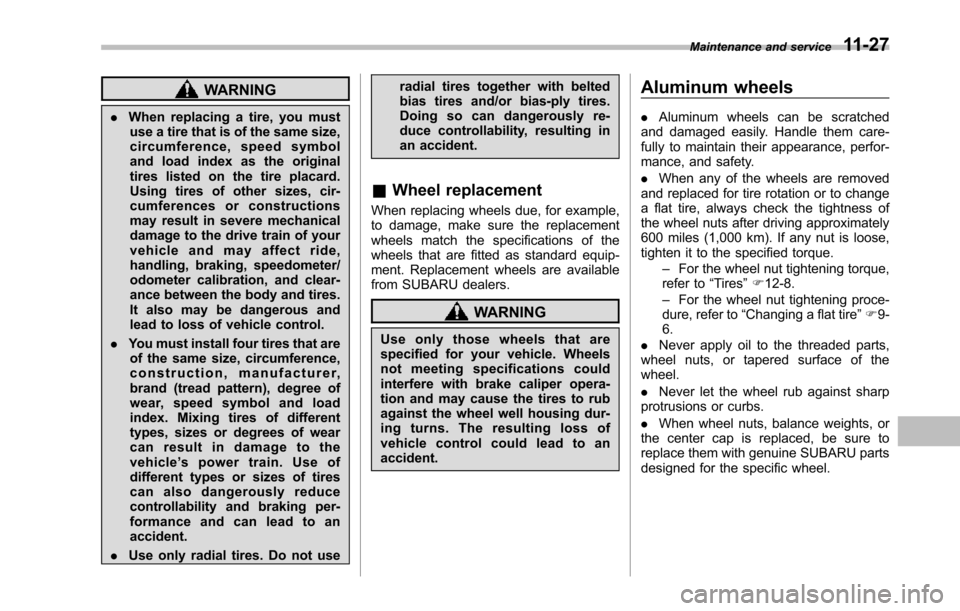
WARNING
.When replacing a tire, you mustuse a tire that is of the same size,circumference, speed symboland load index as the originaltires listed on the tire placard.Using tires of other sizes, cir-cumferences or constructionsmay result in severe mechanicaldamage to the drive train of yourvehicle and may affect ride,handling, braking, speedometer/odometer calibration, and clear-ance betweenthe body and tires.It also may be dangerous andlead to loss of vehicle control.
.You must install four tires that areof the same size, circumference,construction, manufacturer,brand(tread pattern), degree ofwear, speed symbol and loadindex. Mixing tires of differenttypes, sizes or degrees of wearcan result in damage to thevehicle’spowertrain.Useofdifferent types or sizes of tirescan also dangerously reducecontrollability and braking per-formance and can lead to anaccident.
.Use only radial tires. Do not use
radial tires together with beltedbias tires and/or bias-ply tires.Doing so can dangerously re-duce controllability, resulting inan accident.
&Wheel replacement
When replacing wheels due, for example,to damage, make sure the replacementwheels match the specifications of thewheels that are fitted as standard equip-ment. Replacement wheels are availablefrom SUBARUdealers.
WARNING
Use only those wheels that arespecified for your vehicle. Wheelsnot meeting specifications couldinterfere with brake caliper opera-tion and may cause the tires to rubagainst the wheel well housing dur-ing turns. The resulting loss ofvehicle control could lead to anaccident.
Aluminum wheels
.Aluminum wheels can be scratchedand damaged easily. Handle them care-fully to maintain their appearance, perfor-mance, and safety.
.When any of the wheels are removedand replaced for tire rotation or to changea flat tire, always check the tightness ofthe wheel nuts after driving approximately600 miles (1,000 km). If any nut is loose,tighten it to the specified torque.–For the wheel nut tightening torque,refer to“Tires”F12-8.–For the wheel nut tightening proce-dure, refer to“Changing a flat tire”F9-6..Never apply oil to the threaded parts,wheel nuts, or tapered surface of thewheel.
.Never let the wheel rub against sharpprotrusions or curbs.
.When wheel nuts, balance weights, orthe center cap is replaced, be sure toreplace them with genuine SUBARU partsdesigned for the specific wheel.
Maintenance and service11-27
Page 361 of 426
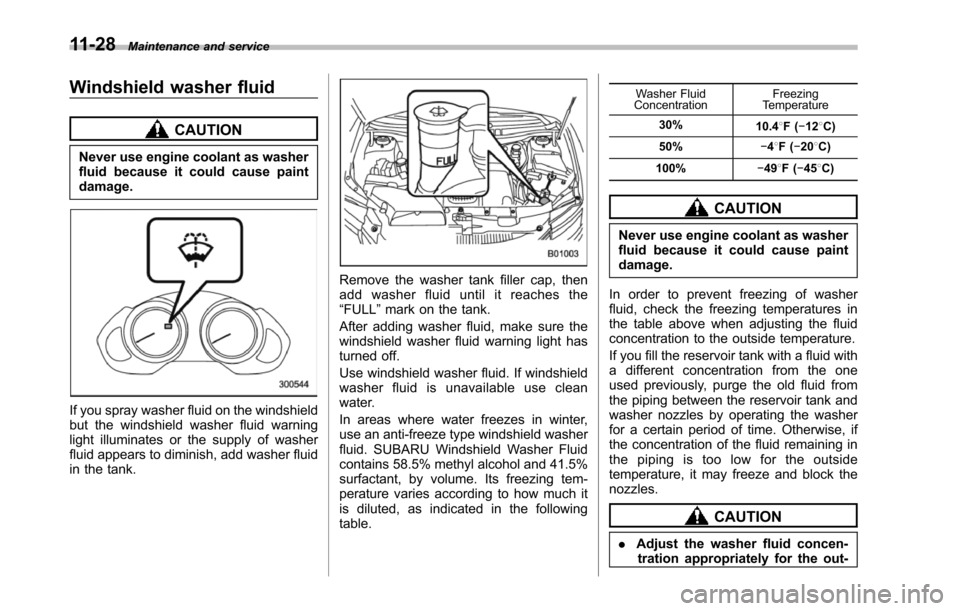
11-28Maintenance and service
Windshield washer fluid
CAUTION
Never use engine coolant as washerfluid because it could cause paintdamage.
If you spray washer fluid on the windshieldbut thewindshield washer fluid warninglight illuminates or the supply of washerfluid appears to diminish, add washer fluidin the tank.
Remove the washer tank filler cap, thenadd washer fluid until it reaches the“FULL”mark on the tank.
After adding washer fluid, make sure thewindshieldwasher fluid warning light hasturned off.
Use windshield washer fluid. If windshieldwasher fluid is unavailable use cleanwater.
In areas where water freezes in winter,use an anti-freeze type windshield washerfluid. SUBARU Windshield Washer Fluidcontains 58.5% methyl alcohol and 41.5%surfactant, by volume. Its freezing tem-perature varies according to how much itis diluted, as indicated in the followingtable.
Washer FluidConcentrationFreezingTemperature
30%10.48F(!128C)
50%!48F(!208C)
100%!498F(!458C)
CAUTION
Never use engine coolant as washerfluid because it could cause paintdamage.
In order to prevent freezing of washerfluid, check the freezing temperatures inthe table above when adjusting the fluidconcentration to the outside temperature.
If you fill the reservoir tank with a fluid witha different concentration from the oneused previously, purge the old fluid fromthe piping between the reservoir tank andwasher nozzles by operating the washerfor a certain period of time. Otherwise, ifthe concentration of the fluid remaining inthe piping is too low for the outsidetemperature, it may freeze and block thenozzles.
CAUTION
.Adjust the washer fluid concen-tration appropriately for the out-
Page 366 of 426
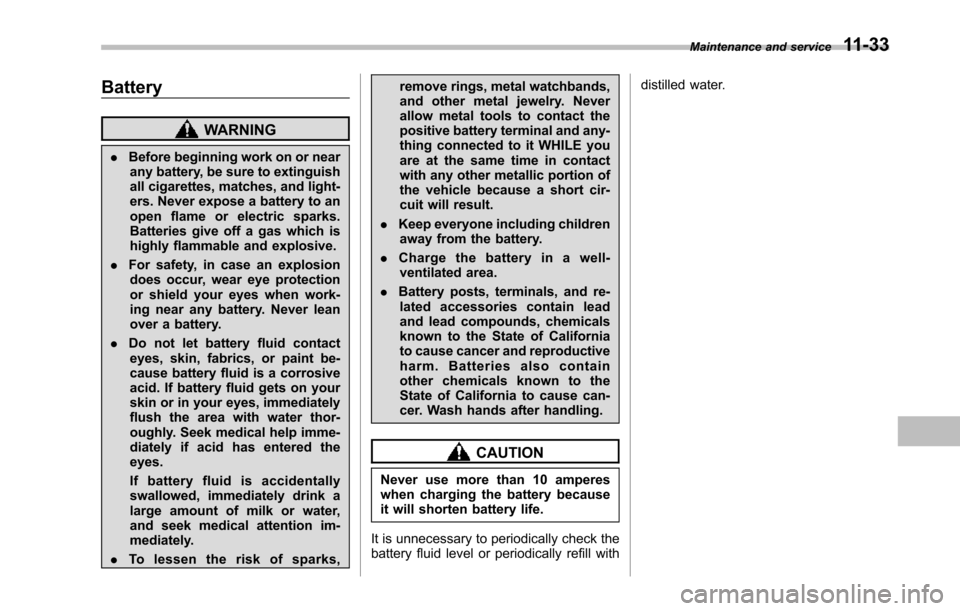
Battery
WARNING
.Before beginning work on or nearany battery, be sure to extinguishall cigarettes, matches, and light-ers. Never exposea battery to anopen flame or electric sparks.Batteries give off a gas which ishighly flammable and explosive.
.For safety, in case an explosiondoes occur, wear eye protectionor shield your eyes when work-ing near any battery. Never leanover a battery.
.Do not let battery fluid contacteyes, skin, fabrics, or paint be-causebattery fluid is a corrosiveacid. If battery fluid gets on yourskin or in your eyes, immediatelyflush the area with water thor-oughly. Seek medical help imme-diately if acid has entered theeyes.
If battery fluid is accidentallyswallowed, immediately drink alarge amount of milk or water,and seek medical attention im-mediately.
.To l e s s e n t h e r i s k o f s p a r k s ,
remove rings, metal watchbands,and other metal jewelry. Neverallow metal tools to contact thepositive battery terminal and any-thing connected to it WHILE youare at the same time in contactwith any other metallic portion ofthe vehicle because a short cir-cuit willresult.
.Keep everyone including childrenaway from the battery.
.Charge the battery in a well-ventilated area.
.Battery posts, terminals, and re-lated accessories contain leadand lead compounds, chemicalsknown to the State of Californiato cause cancer and reproductiveharm. Batteries also containother chemicals known to theState of California to cause can-cer. Wash hands after handling.
CAUTION
Never use morethan 10 ampereswhen charging the battery becauseit will shorten battery life.
It is unnecessary to periodically check thebattery fluid level or periodically refill with
distilled water.
Maintenance and service11-33
Page 369 of 426
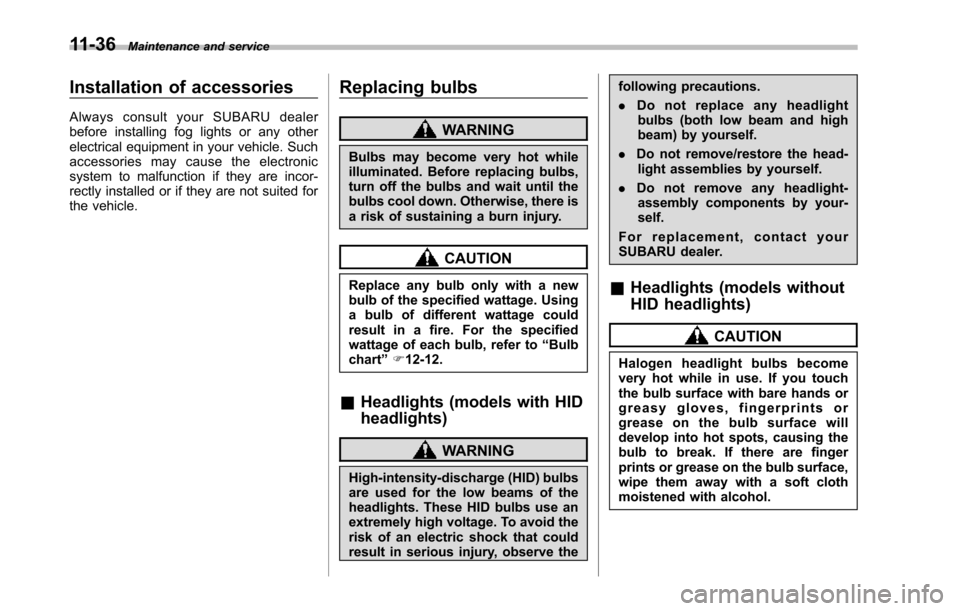
11-36Maintenance and service
Installation of accessories
Always consult your SUBARU dealerbefore installing fog lights or any otherelectrical equipment in your vehicle. Suchaccessories may cause the electronicsystem to malfunction if they are incor-rectly installedor if they are not suited forthe vehicle.
Replacing bulbs
WARNING
Bulbs may become very hot whileilluminated. Before replacing bulbs,turn off the bulbs and wait until thebulbs cooldown. Otherwise, there isa risk of sustaining a burn injury.
CAUTION
Replaceany bulb only with a newbulb of the specified wattage. Usinga bulb of different wattage couldresult in a fire. For the specifiedwattage of each bulb, refer to“Bulbchart”F12-12.
&Headlights (models with HID
headlights)
WARNING
High-intensity-discharge (HID) bulbsare used for the low beams of theheadlights. These HID bulbs use anextremelyhigh voltage. To avoid therisk of an electric shock that couldresult in serious injury, observe the
following precautions.
.Do not replace any headlightbulbs (both low beam and highbeam) by yourself.
.Do not remove/restore the head-light assemblies by yourself.
.Do not remove any headlight-assembly components by your-self.
For replacement, contact yourSUBARU dealer.
&Headlights (models without
HID headlights)
CAUTION
Halogen headlight bulbs becomevery hot while in use. If you touchthebulb surface with bare hands orgreasy gloves, fingerprints orgrease on the bulb surface willdevelop into hot spots, causing thebulb to break. If there are fingerprints or grease on the bulb surface,wipe them away with a soft clothmoistened with alcohol.
Page 388 of 426
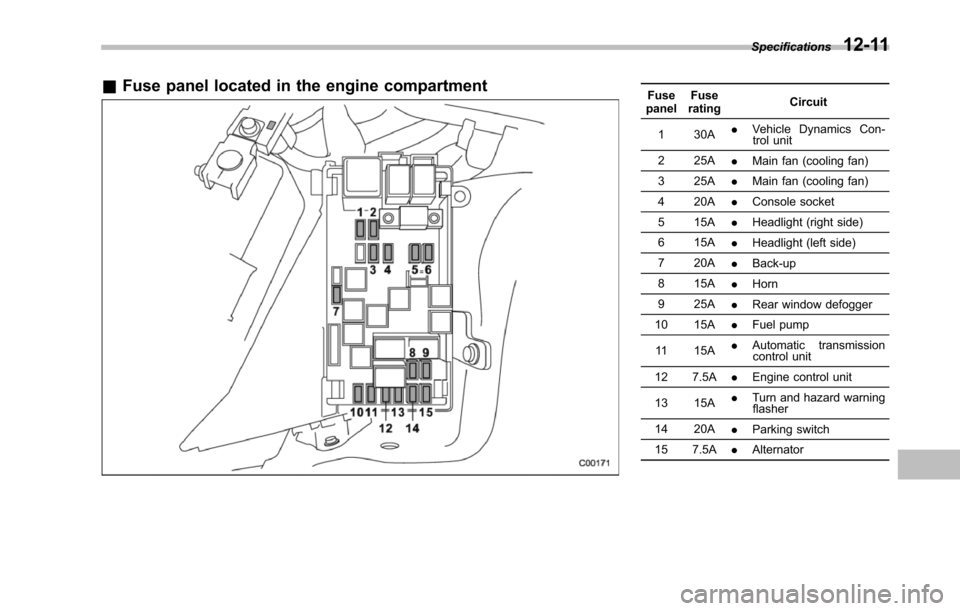
&Fuse panel located in the engine compartmentFusepanelFuseratingCircuit
1 30A.Vehicle Dynamics Con-trol unit
2 25A.Main fan (cooling fan)
3 25A.Main fan (cooling fan)
4 20A.Console socket
5 15A.Headlight (right side)
6 15A.Headlight (left side)
7 20A.Back-up
8 15A.Horn
9 25A.Rear window defogger
10 15A.Fuel pump
11 15A.Automatic transmissioncontrol unit
12 7.5A.Engine control unit
13 15A.Turn and hazard warningflasher
14 20A.Parking switch
15 7.5A.Alternator
Specifications12-11
Page 390 of 426
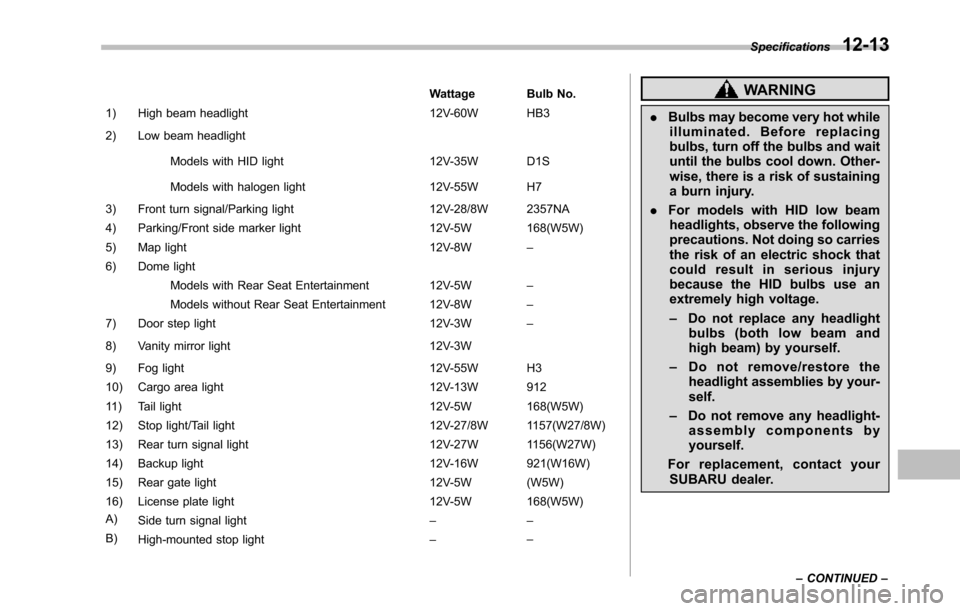
Wattage Bulb No.
1) High beam headlight 12V-60W HB3
2) Low beam headlight
Models with HID light 12V-35W D1S
Models with halogen light 12V-55W H7
3) Front turn signal/Parking light 12V-28/8W 2357NA
4) Parking/Front side marker light 12V-5W 168(W5W)
5) Map light 12V-8W–
6) Dome light
Models with Rear Seat Entertainment 12V-5W–
Models without Rear Seat Entertainment 12V-8W–
7) Door step light 12V-3W–
8) Vanity mirror light 12V-3W
9) Fog light 12V-55W H3
10) Cargo area light 12V-13W 912
11) Tail light 12V-5W 168(W5W)
12) Stop light/Tail light12V-27/8W 1157(W27/8W)
13) Rear turn signal light12V-27W1156(W27W)
14) Backup light 12V-16W 921(W16W)
15) Rear gate light 12V-5W (W5W)
16) License plate light 12V-5W 168(W5W)
A)Side turn signal light––
B)High-mounted stop light––
WARNING
.Bulbs may become very hot whileilluminated. Before replacingbulbs, turn off the bulbs and waituntil the bulbs cool down. Other-wise, there is a risk of sustaininga burn injury.
.For models with HID low beamheadlights, observe the followingprecautions.Not doing so carriesthe risk of an electric shock thatcould result in serious injurybecause the HID bulbs use anextremely high voltage.
–Do not replace any headlightbulbs (both low beam andhigh beam) by yourself.
–Do not remove/restore theheadlight assemblies by your-self.
–Do not remove any headlight-assembly components byyourself.
For replacement, contact yourSUBARU dealer.
Specifications12-13
–CONTINUED–
Page 396 of 426
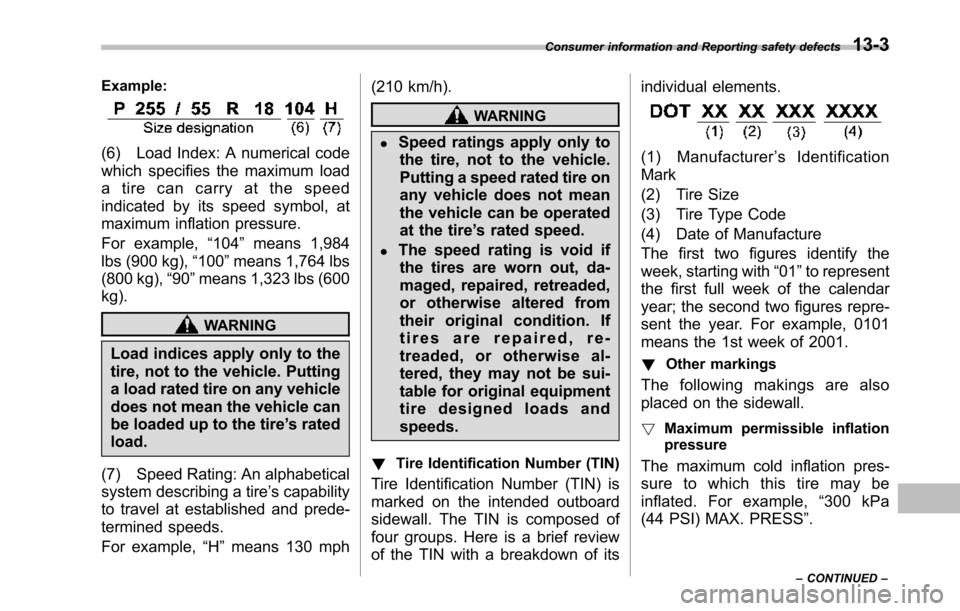
Example:
(6) Load Index: A numerical code
which specifies the maximum load
atirecancarryatthespeed
indicated by its speed symbol, at
maximum inflation pressure.
For example,“104”means 1,984
lbs (900 kg),“100”means 1,764 lbs
(800 kg),“90”means 1,323 lbs (600
kg).
WARNING
Load indices apply only to the
tire, not to the vehicle. Putting
a load rated tire on any vehicle
does not mean the vehicle can
be loaded up to the tire’s rated
load.
(7) Speed Rating: An alphabetical
system describing a tire’s capability
to travel at established and prede-
termined speeds.
For example,“H”means 130 mph
(210 km/h).
WARNING
.Speed ratings apply only to
the tire, not to the vehicle.
Putting a speed rated tire on
any vehicle does not mean
the vehicle can be operated
at the tire’s rated speed.
.The speed rating is void if
the tires are worn out, da-
maged, repaired, retreaded,
or otherwise altered from
their original condition. If
tires are repaired, re-
treaded, or otherwise al-
tered, they may not be sui-
table for original equipment
tire designed loads and
speeds.
!Tire Identification Number (TIN)
Tire Identification Number (TIN) is
marked on the intended outboard
sidewall. The TIN is composed of
four groups. Here is a brief review
of the TIN with a breakdown of its
individual elements.
(1) Manufacturer’sIdentification
Mark
(2) Tire Size
(3) Tire Type Code
(4) Date of Manufacture
The first two figures identify the
week, starting with“01”to represent
the first full week of the calendar
year; the second two figures repre-
sent the year. For example, 0101
means the 1st week of 2001.
!Other markings
The following makings are also
placed on the sidewall.
!Maximum permissible inflation
pressure
The maximum cold inflation pres-
sure to which this tire may be
inflated. For example,“300 kPa
(44 PSI) MAX. PRESS”.
Consumer information and Reporting safety defects13-3
–CONTINUED–